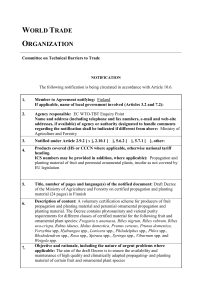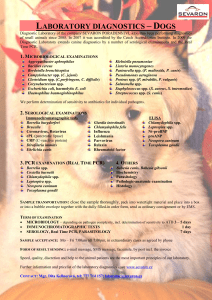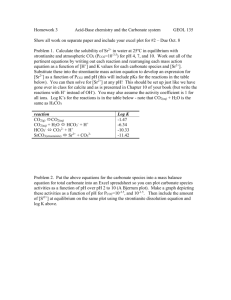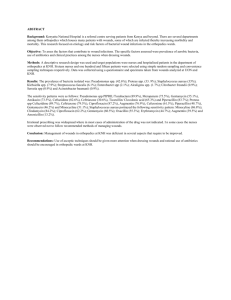English
advertisement
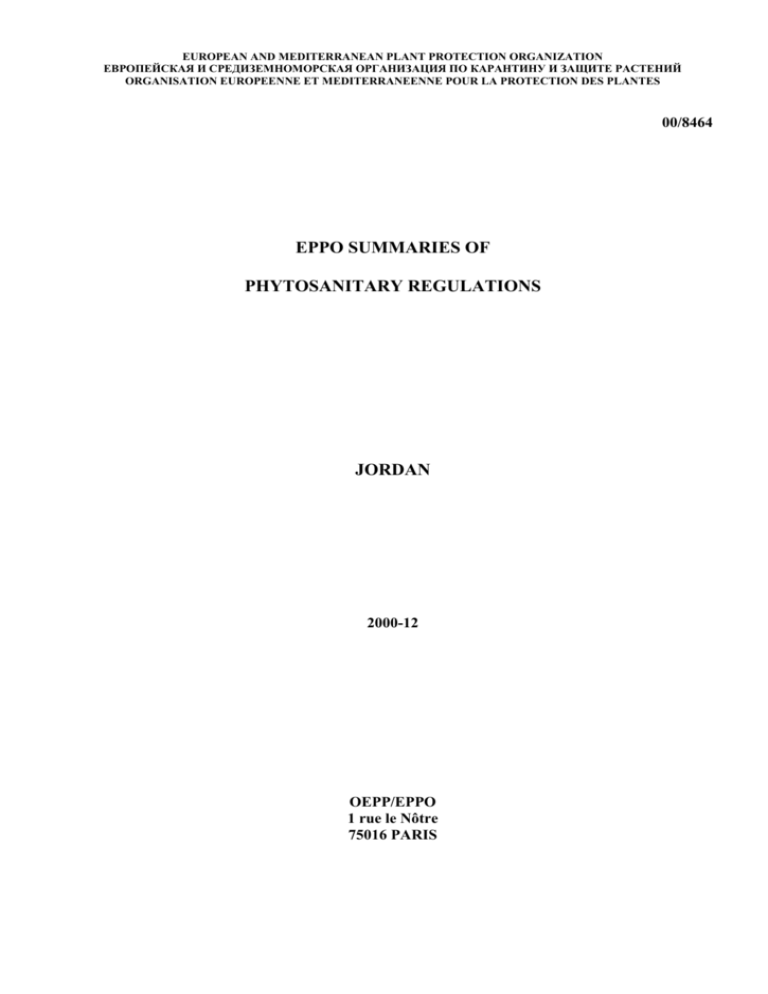
EUROPEAN AND MEDITERRANEAN PLANT PROTECTION ORGANIZATION ЕВРОПЕЙСКАЯ И СРЕДИЗЕМНОМОРСКАЯ ОРГАНИЗАЦИЯ ПО КАРАНТИНУ И ЗАЩИТЕ РАСТЕНИЙ ORGANISATION EUROPEENNE ET MEDITERRANEENNE POUR LA PROTECTION DES PLANTES 00/8464 EPPO SUMMARIES OF PHYTOSANITARY REGULATIONS JORDAN 2000-12 OEPP/EPPO 1 rue le Nôtre 75016 PARIS EPPO SUMMARY OF THE PHYTOSANITARY REGULATIONS OF JORDAN This summary of the phytosanitary regulations of Jordan forms part of the EPPO publication Summaries of Phytosanitary Regulations. It has been prepared by the EPPO Secretariat from the original text of the Jordanian regulations. Its content is identical to that of EPPO's computer database PRS. PRS is provided with a user-friendly interface for retrieval of this information in relation to consignments of specific commodities exported to Jordan from any country. Users are strongly advised to consult PRS in the first instance, and to refer to this printed summary only for an overall view. The original text of the Jordanian regulations is also supplied with PRS, as a computer text file. This summary has been submitted to the NPPO of Jordan for review, and is believed to contain complete and up-to-date information. Nevertheless, it does not constitute a legally approved substitute for the original text of the Jordanian regulations. If in doubt, users should refer to the original text. The summary is presented in the following sequence: General requirements Commodity requirements for: Plants Bulbs and tubers Seeds Cut flowers and branches Fruits and vegetables Squared wood Non-squared wood Bark Soil/growing medium Stored products Other The summary uses the terminology of the Glossary of Phytosanitary Terms (ISPM No. 5), which is supplied with PRS. It also uses a number of 'standard phrases', enclosed in inverted commas, whose full definition is given in PRS and in the introduction to the complete set of Summaries. 2000-12 JORDAN GENERAL PHYTOSANITARY REGULATIONS OF JORDAN General Requirements NPPO Plant Protection Department Ministry of Agriculture P.O. Box 961043 AMMAN 61000 Jordan Tel. : (962) 6 686 151 Fax. : (962) 6 686 310 Telex : 24176 Contact : Dr. Mazen KHASAWNEH (Director) LEGISLATION Act N° 1/WN of 1974 “List of plant pests that are hazardous to plants and agricultural products” issued in conformity with Article 75 of the Agricultural Law N° 20 of 1973 Act N° 2/WN of 1974 “Disinfection treatment of plant consignments and agricultural products” issued in conformity with Article 75 of the Agricultural Law N° 20 of 1973 Act N° 3/WN of 1974 “Prohibition of the entry into the country of plants and agricultural products” issued in conformity with Article 75 of the Agricultural Law N° 20 of 1973 Act N° 4/WN of 1974 “Licenses for import and export of plants and agricultural products and the cases for exemption” issued in conformity with Article 75 of the Agricultural Law N° 20 of 1973 Act N° 5/WN of 1974 “Measures to be taken for consignments which are refused entry into the country or transit” issued in conformity with Article 75 of the Agricultural Law N° 20 of 1973 Act N° 6/WN of 1974 “Authorisation of importation of prohibited materials for scientific purposes” issued in conformity with Article 75 of the Agricultural Law N° 20 of 1973 Act N° 7/WN of 1974 “Licenses for export of plants and agricultural products” issued in conformity with Article 75 of the Agricultural Law N° 20 of 1973 Act N° 8/WN of 1974 “Transit of plants and agricultural products” issued in conformity with Article 75 of the Agricultural Law N° 20 of 1973 Act N° 9/WN of 1974 “Entry into the country and processing of imported plant consignments which are infected with pests” issued in conformity with Article 75 of the Agricultural Law N° 20 of 1973 2000-12 Act N° 10/WN of 1974 “Import of honey bees” issued in conformity with Article 75 of the Agricultural Law N° 20 of 1973 PROHIBITED IMPORTS Living agricultural pests in all stages including bacteria and fungi harmful to plants. Plants, plant products and other materials infested by quarantine pests (Lists A1 and A2 under heading 4) unless subjected to disinfection treatment 1. Plants, plant products and other materials infested by unknown pests. Soil containing organic matter (except sand and mud intended for the pottery and porcelain industry transported under the supervision of phytosanitary inspectors). Natural organic fertilizers. Plants, plant products and other materials accompanied by soil, compost or other prohibited materials. Containers or other packing materials previously used in exporting countries for packing or transporting prohibited materials. Plants and agricultural waste products from ships and planes. Exceptions Prohibited materials may be imported for scientific purposes by scientific bodies or governmental institutions with the prior approval of the Ministry of Agriculture. POINTS OF ENTRY Plants and plant products must be imported through specified points of entry. TRANSIT Transit of consignments of plants and plant products is allowed in sealed containers (boxes, sacks, etc.) held in conveyances which are locked or totally sealed and covered with waterproof material. These consignments 1 Infested consignments must be subjected to disinfection treatment within seven days from the date of inspection. The fumigation or other treatment must guarantee eradication of all stages of the pests. JO-1 JORDAN GENERAL are subject to phytosanitary inspection if they stay on the territory of Jordan for more than 7 days. They must be free from quarantine pests and can be opened only in presence of a phytosanitary inspector. PC should carry an additional declaration (AD). LISTS OF QUARANTINE PESTS List A1 IMPORT PERMITS An import permit (IP) (“license”) is in general required for any importation of plants and plant products (see exceptions below). Requests for IPs should be forwarded by the importer to the Ministry of Agriculture before the shipping of any consignments. An IP is valid for a period of one year starting from the date of issuing by the Ministry of Agriculture. Exceptions No IP is required : - for plants and plant products carried by passengers (not exceeding 30 kg per person); - for plants and plant products imported for personal use (not exceeding 30 kg per person); - for plants and plant international bodies; - for plants and plant products imported for diplomatic and consular missions and their foreign members; - for plants and plant products Government and public institutions; - for plants and plant products imported for scientific bodies; - for plants and plant products imported as commercial samples; - for postal parcels; products imported imported for for - for confiscated and abandoned commodities unclaimed by their owners. CERTIFICATES The phytosanitary certificate (PC) must be issued by the NPPO of the country of origin for all plants and plant products in conformity with Art. V of the IPPC, 1951. The PC must be based on an official phytosanitary inspection in the exporting country during which the consignment must have been found healthy and free from pests. The PC must contain botanical names of plants and the area of their origin. The re-export certificate (RC) is required for consignments exported by a country which is not the country of origin. In some cases mentioned in the headings concerned, the JO-2 Quarantine pests which are not present in Jordan and whose introduction into the country is prohibited unless subjected to disinfection treatment Animals Acanthoscelides spp. Anguina pratensis (?) Anguina tritici Asterolecanium pustulans Bactrocera (= Dacus) dorsalis Brevipalpus obovatus Caryedon serratus Chlorophorus varius Ditylenchus angustus Erythroneura coacta (?) Eurygaster integriceps Leptinotarsa decemlineata Lixus anguinus Orthezia insignis Popillia japonica Ptosima undecimmaculata Rhagoletis cerasi Rhopalomyia (= Diarthronomyia) chrysanthemi Schneidereria (= Recurvaria) pistaciicola Sesia (= Aegeria) apiformis Sphaerolecanium prunastri Tarsonemus spp. Unaspis citri Bacteria Clavibacter michiganensis subsp. sepedonicus (= Corynebacterium sepedonicum) Erwinia carotovora subsp. atroseptica (= Erwinia atroseptica) Peach yellows phytoplasma Pseudomonas syringae pv. tomato (= Pseudomonas tomato) Ralstonia (= Pseudomonas) solanacearum Streptomyces scabies Xanthomonas axonopodis pv. phaseoli (= Xanthomonas phaseoli) Fungi Ascochyta spp. Botrytis tulipae Cercospora nicotianae Chalara (= Thielaviopsis) spp. Claviceps purpurea Colletotrichum coccodes (= Colletotrichum phomoides) Corticium spp. Corynespora (= Cercospora) melongenae Cryptosporella (= Phomopsis) viticola 2000-12 JORDAN Elsinoe phaseoli Elsinoe piri Glomerella cingulata (= Colletotrichum gloeosporioides f.sp. melongenae) Glomerella cingulata (= Gloeosporium olivarum) Guignardia bidwellii Macrophomina melonis (?) Macrophomina phaseolina (= Macrophomina phaseoli) Magnaporthe (= Piricularia) spp. Phoma destructiva Phomopsis tuberivora Phyllosticta viticola Plasmodiophora brassicae Pleospora spp Pseudocercospora (= Cercospora) fuligena Sclerotinia bulborum Septoria lycopersici Spongospora subterranea Synchytrium endobioticum Taphrina bullata Urocystis agropyri (= Urocystis tritici) Valsa (= Cytospora) spp. Verticillium albo-atrum Viruses and virus-like organisms Potato spindle tuber viroid Ring spot virus (?) List A2 Quarantine pests which are present in Jordan and whose introduction into the country is prohibited unless subjected to disinfection treatment Animals Acarus spp. Aceria (= Eriophyes) oleae Aceria ficus Aceria sheldoni Aleurodidae sp. Aleurotrachelus citri Anarsia lineatella Anguina tritici Anthonomus pomorum Anthrenus spp. Aonidiella aurantii Apate monachus Aphelenchoides fragariae Aphis duranti Aphis gossypii Aphis pomi Bactrocera (= Dacus) oleae Bemisia tabaci Brachycaudus amygdalinus Brachycaudus helichrysi Brevicoryne brassicae Bruchus lentis Bruchus pisorum Bruchus rufimanus Caliroa spp. 2000-12 GENERAL Capnodis spp. Carpophilus dimidiatus Carpophilus hemipterus Carpophilus mutilatus Cephus pygmeus (= C. pygmaeus) Ceratitis capitata Ceroplastes floridensis Ceroplastes rusci Chrysomphalus aonidum Chysobothris spp. Coccus hesperidum Colomerus (= Eriophyes) vitis Cryptolestes (= Laemophloeus) ferrugineus Cryptolestes (= Laemophloeus) pusillus Cryptolestes (= Laemophloeus) turcicus Cydia (= Carpocapsa) pomonella Cydia (= Laspeyresia) nigricana Dasineura (= Dasyneura) spp. Dasineura oleae Dermestes maculatus (= D. vulpinus) Deudorix (= Virachola) livia Diloba caeruleocephala Ditylenchus spp. Earias insulana Empoasca spp. Eotetranychus tiliarius (= Tetranychus telarius) Ephestia spp. Eriophyes pyri Eriosoma lanigerum Euphyllura olivina Eurytoma amygdali Eurytoma pistaciae Geometridae spp. Globodera (= Heterodera) rostochiensis Helicotylenchus spp. Helicoverpa (= Heliothis) zea Helicoverpa armigera Hylesinus oleiperda Hylesinus spp. Hypera postica (= Phytonomus variabilis) Icerya purchasi Lasioderma serricorne Latheticus oryzae Lepidosaphes beckii Lepidosaphes spp. Lobesia (= Polychrosis) botrana Lonchaea aristella Megachile spp. Meloidogyne spp. Melolontha melolontha (Cockchafer) Microcerotermes diversus Monosteira unicostata Myiopardalis pardalina Myzus persicae Oryzaephilus surinamensis Ostrinia (= Pyrausta) nubilalis Pachypasa otus Parlatoria oleae Pemphigus spp. Phloeotribus scarabaeoides (= P. oleae) Phyllocoptruta oleivora Pieris brassicae Pieris rapae JO-3 JORDAN Planococcus (= Pseudococcus) citri Plutella xylostella (= P. maculipennis) Pratylenchus spp. Prays oleae Psocoptera spp. Psylla spp. Pterochloroides persicae Quadraspidiotus (= Aspidiotus) perniciosus Rattus spp. Resseliella (= Clinodiplosis) oleisuga Retithrips syriacus Rhizoglyphus echinopus Rhyzopertha dominica Saissetia oleae Scolytus rugulosus Scythris (= Syringopais) temperatella Sesamia cretica Siphoninus granati Sitophilus granarius Sitophilus oryzae Sitotroga cerealella Sphenoptera spp. Stephanitis pyri Tenebroides mauritanicus Thrips spp. Toxoptera aurantii Toxoptera citricida Tribolium castaneum Tribolium confusum Trioza buxtoni Trogoderma granarium Tylenchulus semipenetrans Xiphinema spp. Zeuzera pyrina Bacteria Erwinia amylovora Erwinia carotovora Pseudomonas savastanoi Pseudomonas syringae pv. lachrymans (= Pseudomonas lachrymans) Xanthomonas arboricola pv. pruni (= Xanthomonas pruni) Fungi Alternaria spp. Aspergillus niger Botryosphaeria rhodina (= Diplodia natalensis) Botryotinia fuckeliana (= Botrytis cinerea) Botrytis allii Capnodium spp. Cercospora beticola Cercospora punicae Cercospora zonata (= Cercospora fabae) Cladosporium variabile (= Heterosporium variabile) Cochliobolus sativus (= Helminthosporium sativum) Colletotrichum circinans Colletotrichum lagenarium Colletotrichum tabacum Corticium rolfsii JO-4 GENERAL Diaporthe (= Phomopsis) citri Diaporthe (= Phomopsis) vexans Elsinoe ampelina (= Gloeosporium ampelophagum) Erysiphe cichoracearum Erysiphe graminis Erysiphe polygoni Fulvia fulva (= Cladosporium fulvum) Fusarium oxysporum Gibberella zeae Glomerella cingulata (= Colletotrichum gloeosporioides) Helicobasidium brebissonii (= Rhizoctonia violaceae) Leveillula taurica Mauginiella scaettae Monilinia (= Monilia) fructigena Monilinia laxa (= Monilia cinerea) Mycosphaerella brassicicola Mycosphaerella fragariae Mycosphaerella graminicola (= Septoria tritici) Mycosphaerella musicola (= Cercospora musae) Nectria haematococca (= Fusarium solani) Penicillium spp. Peronospora cubensis Peronospora destructor Peronospora farinosa (= Peronospora schachtii) Peronospora parasitica Peyronollaea spp. Phyllosticta spp. Phytophthora citrophthora Phytophthora fragariae Phytophthora infestans Phytophthora nicotianae var. parasitica (= Phytophthora parasitica) Podosphaera clandestina (= Podosphaera oxycanthae) Podosphaera leucotricha Pseudopeziza tracheiphila Puccinia spp. Pyrenophora graminea (= Helminthosporium gramineum) Pyrenophora teres (= Helminthosporium teres) Pythium spp. Rosellinia necatrix Sclerotinia sclerotiorum Sphacelotheca cruenta Sphaerotheca pannosa Spilocaea oleagina (= Cycloconium oleaginum) Spilocaea pyracanthae (= Fusicladium eriobotryae) Stigmina carpophila (= Coryneum beijerinckii) Taphrina deformans Thanatephorus cucumeris (= Rhizoctonia solani) Tilletia tritici (= Tilletia caries) Transchelia pruni-spinosae Uncinula necator Uromyces appendiculatus (= Uromyces phaseoli) Uromyces trifolii Uromyces viciae-fabae (= Uromyces fabae) Ustilago maydis Ustilago nuda (= Ustilago tritici) Venturia inaequalis Verticillium theobromae 2000-12 JORDAN GENERAL Viruses and virus-like organisms Leaf curl virus (?) Mosaic virus (?) Citrus ringspot virus (= Citrus psorosis virus) PHYTOSANITARY REGULATIONS OF JORDAN Commodity Requirements for Plants Note that the term "Plants" used under this heading must be understood as an abbreviation for "Plants for planting, except seeds, bulbs and tubers". All plants PC and, if appropriate, RC IP Free from soil Musa All plants Free from virus and virus-like diseases (AD) Prunus domestica All plants Free from virus and virus-like diseases (AD) Prunus persica All plants Free from virus and virus-like diseases (AD) PHYTOSANITARY REGULATIONS OF JORDAN Commodity Requirements for Bulbs and Tubers All bulbs and tubers PC and, if appropriate, RC IP Free from soil Gladiolus All bulbs 2000-12 Free from virus and virus-like diseases (AD) JO-5 JORDAN BULBS AND TUBERS Solanum tuberosum Seed potato tubers AD declaring that the potatoes are intended for sowing (AD) Virus infection rate of crop less than 2% (AD) Free from Clavibacter michiganensis subsp. sepedonicus, Ditylenchus destructor, Erwinia carotovora, Globodera rostochiensis, Leptinotarsa decemlineata, Meloidogyne spp., Phthorimaea operculella, Popillia japonica, potato corky ring spot virus (?), potato leaf roll luteovirus, potato spindle tuber viroid, potato yellow dwarf nucleorhabdovirus, Ralstonia solanacearum and Synchytrium endobioticum Free from frost damage Total damage by Alternaria solani, Fusarium spp., hollow heart of potato, Phytophthora infestans, Sclerotium spp. and mechanical damage less than 0.5% Surface area infection by Streptomyces scabies less than 5% Infection by potato A potyvirus, potato leaf roll luteovirus, potato M carlavirus, potato X potexvirus and potato Y potyvirus in conformity with internationally approved standards for seed potatoes Free from Clavibacter michiganensis subsp. sepedonicus, Erwinia carotovora, Globodera rostochiensis, Leptinotarsa decemlineata and Synchytrium endobioticum (AD) 'Area freedom' for Clavibacter michiganensis subsp. sepedonicus, Erwinia carotovora, Globodera rostochiensis, Leptinotarsa decemlineata and Synchytrium endobioticum (AD) PHYTOSANITARY REGULATIONS OF JORDAN Commodity Requirements for Seeds All seeds PC and, if appropriate, RC IP Vegetable seeds JO-6 Free from symptoms of seed-transmitted virus diseases (AD) 2000-12 JORDAN SEEDS Vegetable plants Vegetable seeds Free from symptoms of seed-transmitted virus diseases (AD) PHYTOSANITARY REGULATIONS OF JORDAN Commodity Requirements for Cut Flowers and Branches All cut flowers and branches IP PHYTOSANITARY REGULATIONS OF JORDAN Commodity Requirements for Fruits and Vegetables All fruits and vegetables PC and, if appropriate, RC IP Free from soil Solanum tuberosum Ware potatoes Free from Clavibacter michiganensis subsp. sepedonicus, Erwinia carotovora, Globodera rostochiensis, Leptinotarsa decemlineata and Synchytrium endobioticum (AD) 'Area freedom' for Clavibacter michiganensis subsp. sepedonicus, Erwinia carotovora, Globodera rostochiensis, Leptinotarsa decemlineata and Synchytrium endobioticum (AD) PHYTOSANITARY REGULATIONS OF JORDAN Commodity Requirements for Squared Wood Squared wood 2000-12 IP JO-7 JORDAN NON-SQUARED WOOD PHYTOSANITARY REGULATIONS OF JORDAN Commodity Requirements for Non-squared Wood Non-squared wood IP PHYTOSANITARY REGULATIONS OF JORDAN Commodity Requirements for Bark All isolated bark IP PHYTOSANITARY REGULATIONS OF JORDAN Commodity Requirements for Soil/growing Medium Natural organic fertilizers Prohibited All growing medium IP Soil or other organic growing medium (except sand and mud intended for pottery and porcelain industry) Prohibited PHYTOSANITARY REGULATIONS OF JORDAN Commodity Requirements for Stored Products All stored products PC and, if appropriate, RC IP JO-8 2000-12 JORDAN POLLEN PHYTOSANITARY REGULATIONS OF JORDAN Commodity Requirements for Pollen All pollen PC and, if appropriate, RC IP 2000-12 JO-9




